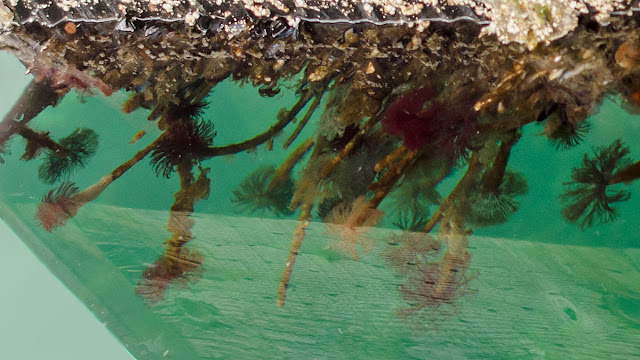I noticed the smells first; salt, creosote, tar, old wood, engines, something mildly fishy. I was going down the ramp to the dock where the working boats, the fishing and tug boats, tie up, and the scents took me back to a time when I used to fish off a similar dock, catching supper. An old memory surfaced; old log pilings, tarred, at the end of a dock, and a big (well, maybe; I was little) octopus climbing up and peering out of the square opening.
I didn't expect octopuses here; starfish and anemones, probably. I walked down to the end of three long docks, squinting down every gap between dock and boat, every opening for pilings. There wasn't much to be seen; the boats are tied up, two deep, on each side of the dock. Very little light filters down underneath them. And many of the pilings are metal; fat, rusty pipes standing out of the water. Nothing seems to live on them.
But where I found tarred log pilings and a bit of reflected light, I found shrimp. And 'way down at the end of the last dock, where the sunlight penetrates to those log pilings, I found a starfish climbing out of the water. I got down on my knees, then lay flat, ending up lying for a long time with my head and camera down the hole between the pilings.
Because the pilings were alive with things crawling about.
 |
| The starfish, half out of water. |
There were a fair number of purple starfish. Earlier, I had seen a few pale orange ones, deep down, one in not very good shape. But these were active, crawling about or hunched over something edible. They all looked healthy.
In the photo above, all that white stuff is styrofoam. Tiny, white balls of styrofoam. I found these all along the dock, along the water line of the boats, stuck to the tarry pilings. (Not the metal ones.) I had to keep brushing floating clumps aside to see the animals below.
There wasn't much in the way of seaweeds around the pilings or on the boats. I saw a few kelp streamers, loose in the current, and a few blades of red algae. There seems to be more underneath the dock, but I couldn't see more than bits of the edge.
The kelp crabs keep walking around and around the pilings; as one disappears on the far side, the first legs of the next show up. Round and round and round; I never saw any of them stop to eat anything, but they must be finding something worthwhile.
 |
| Older kelp crab, growing pale seaweeds on his back. He's deeper down; there's only a hint of styrofoam in the foreground. The little toe tips at the top belong to a pair of shrimp on the far side of the piling. |
 |
| Much smaller crab, possibly the red rock crab, with barnacle scars and a few remnants of styrofoam. |
 |
| Another coonstripe shrimp. With floating styrofoam. The yellow mound is some sort of sponge. And what's that down at the corner? |
That mottled brown thing with the blue vanes showed up in quite a few photos; in each one, the vanes were in a different position. Unfortunately, I hadn't noticed it while I was taking the photos, paying attention to the shrimp.
 |
| Mystery critter. |
From the shape of this animal, and the waving vanes, I thought it might be a nudibranch, but I've looked at all those in my
encyclopedia, and hundreds that Google found for me. Nothing looks right.
Comparing it with the shrimp, which was about 4 inches long, I would guess that it is probably about an inch long. There are brown, mottled nudibranchs the right size, the barnacle-eating nudibranch,
Onchidoris bilamellata, for example, but the vanes would be gills, and they should be feathery, and maybe smaller. But they would explain the number of empty barnacle scars on these pilings.
Help!





































